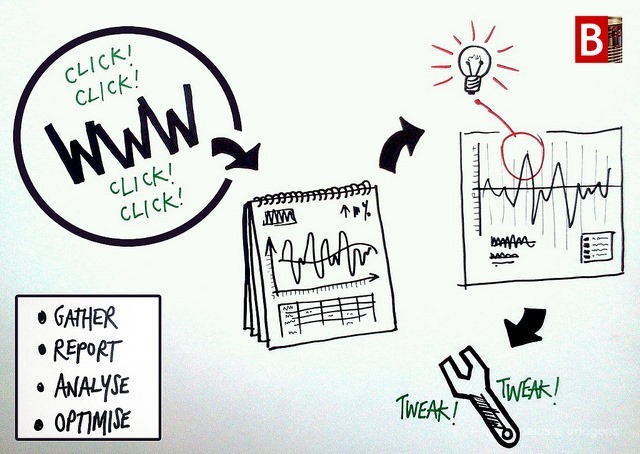
Analyze by Beantin webbkommunikation
If your marketing is supposed to be a mix, and if there’s a possibility that you’d be using a wide range of marketing channels to promote your business, that’s a lot of money you are investing. For all that money, there ought to be an ROI. On SEP, we cover a lot on analytics, dashboards, and ROI.
But almost always, there’s emphasis on Google Analytics. Of course Google Analytics is awesome. Andrew Marsh recently published a post on how to interpret Google Analytics data. He points out how your traffic patterns work, how traffic patterns shift over time, and also know a lot more about how your blogging, SEO, social media, and email marketing campaigns work.
Tyler Calder wrote on why standard reporting sucks and how predictive analyses holds a promise for marketers.
Depending on your business, your marketing mix, and your demographics, Google Analytics might not even be telling you the complete story. Half-baked data leads often leads to wrong decisions. Sometimes, you need to go beyond Google Analytics.
It’s even better if you can setup a streamlined, all-inclusive workflow for your analytics. In most cases, you’ll require a combination of other tools along with Google Analytics. Here’s how you can do it:
General Web Analytics Dashboards
If you are online, you want to measure traffic, bounce rates, time spent on pages, what visitors do on pages, where they come from, and the devices they use, etc. Here are the best dashboards for you to consider:
Google Analytics
Its your main analytics engine, but it can only tell you so much. Its designed to help websites of all types and all sizes. For larger sites, Google Analytics does have issues in terms of sampling as Adam Cassar of Periscopic detailed in this post.
With Google Analytics, you can create specific dashboards for all sorts of goals and track almost everything you wanted to. Marcela De Vivo helpfully points to specific dashboards for SEO, PPC, Brand Monitoring, Brand Engagement, Social Media, and more.
Start with Google Analytics, but don’t just stop there.
Cyfe
Cyfe is a different animal. It’s a dashboard that brings in the numbers from almost all of your web properties and not just your website, social media, email campaigns, paid advertising, and others. For instance, you can pull in the numbers for the following:
- Pull in instances of customer service tickets from Zendesk or Salesforces Desk.
- Know how many people signed up, attended, and viewed your webinars on GoToWebinar
- Get instant numbers on how many people view or download your slide decks on SlideShare
- Track traffic and conversions on your Unbounce landing pages.
If you run out of pre-built widgets available at Cyfe, you can build your own custom widgets.
Social Analytics Dashboards
Social media is tricky — its not just about making pitches, putting up ads, and looking for conversions when it comes to this medium. There are also conversations, engagement, and traction.
There’s branding, brand monitoring, conversation management, and more. Just knowing how many visitors came to your pages from Facebook, Twitter, Google+, and LinkedIn wont give you the complete picture.
Simply Measured
Google Analytics tells you how each social network contributes to your traffic inflow. It can also point out how these visitors flow from social networks to your site, and also how and where they drop off. Meanwhile, you can track social conversions too.
Yet, Google Analytics doesn’t tell how each of your social networks is performing. How many Twitter followers did you gain in the past month? How has your did your Facebook business page grow? Simply Measured has a robust set of tools to help you understand your social networks better. You also have a free set of tools to try.
Hootsuite
Now, HootSuite isn’t new to us here. Most of us use HootSuite to engage, interact, schedule posts, and more. But there’s analytics built in for HootSuite that you can use to pull out information in a variety of ways to get insights on your social media performance. Reports can be dug up for your profiles on Twitter, Facebook, Google+ and LinkedIn pages.
Ian Cleary of Razor Social has a list of even more all-inclusive social media tools for you to consider.
Lead/Conversion Dashboards
Every business has focus on leads generated. It’s not hard to see why, of course. Its critical for cash flow and its the crux for generating profits. Thankfully, you have a way to track leads and conversions with virtually any tool you might be using for lead generation.
Landing Pages
Let’s assume that you use Unbounce, LanderApp, Wishpond, or KickOffPages for building landing pages. Each of these tools has an in-built analytics dashboard for you to stay on top of your numbers. Of course, you could always track landing page performance from a single dashboard like Google Analytics or Cyfe. There could still be some data missing, however.
Consider Unbounce: if you use A/B testing, you’d have the performance of each variant matched with the other variant. Now, this data won’t get into your Google Analytics (what gets in is standalone performance of either variant).
Email Campaigns
Generally, you’d be able to track results of your email campaigns on GA. But then, if you’d like to know a lot more such as open rates, subscriber counts, unsubscribes, results off subject line A/B tests, and field conversations off email campaigns, dig into the analytics and reports that your email provider gives you.
Leading providers such as MailChimp and Campaign Monitor make all this data available to you instantly, in real time.
A/B Testing For Web Pages
If you do A/B testing on any of your web pages, the results of your tests are hard to find from Google Analytics. Now, each page can have a goal and you can measure goals achieved for each page.
But why go that extra mile when Optimizely has analytics that show you how your tests are performing? For every design element, page, blog post, and various calls to action, going into Optimizely Analytics is still a viable option. Either that or build a custom widget to port this data into Cyfe.
To Wrap Up
The good news is that instead of logging into every tool you use for lead generation, email campaigns, paid ads, social media, and more, you can just use a combination of one or two that you’re comfortable with. When you’re getting full value from your existing options, you can considering adding the next tool to your arsenal.
How do you build your analytics dashboards?
Post from: Search Engine People SEO Blog
How to Setup a Streamlined Workflow for Your Analytics
—
Written by Pratik Dholakiya, E2M Solutions Blog
The post How to Setup a Streamlined Workflow for Your Analytics appeared first on Search Engine People Blog.
(620)






